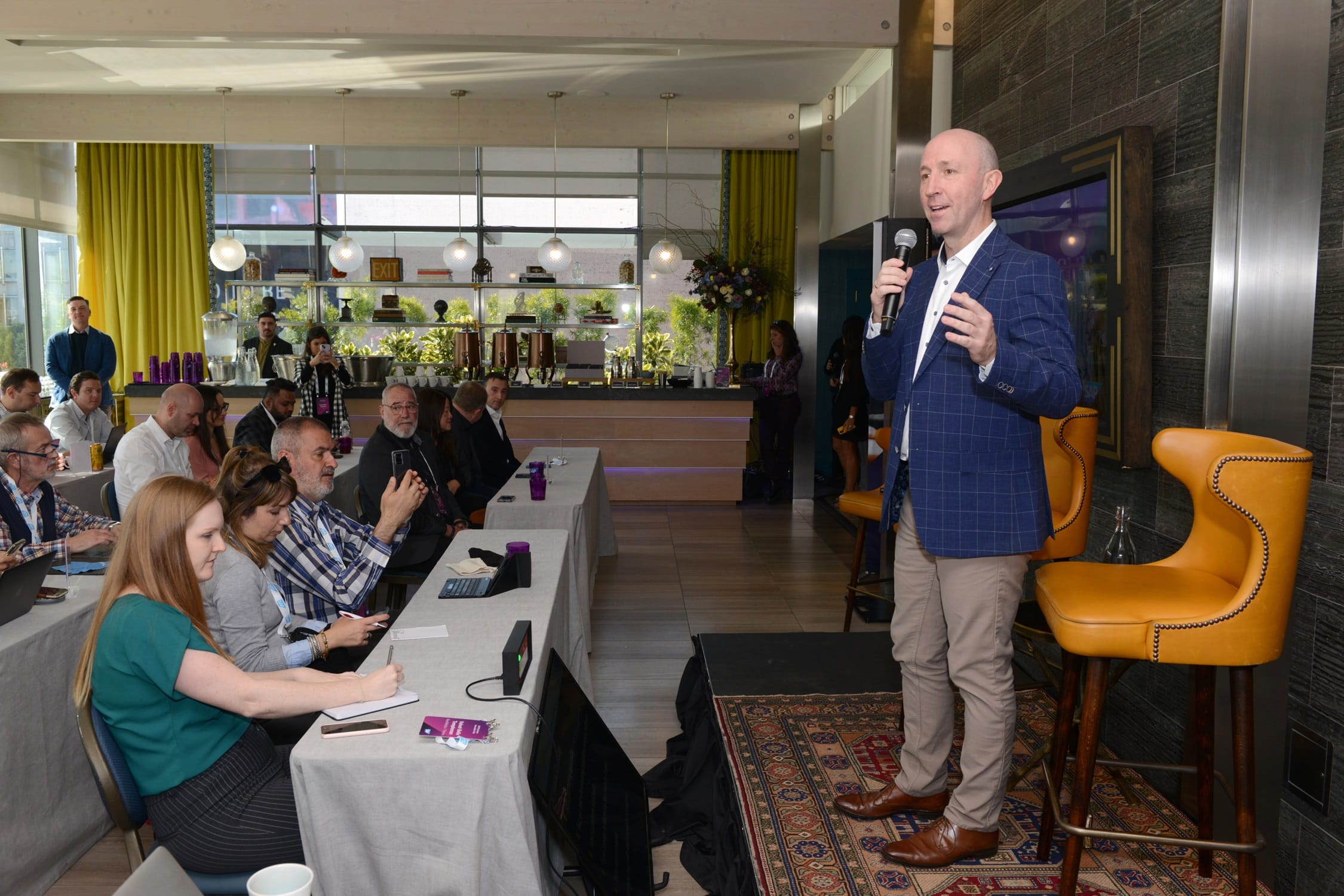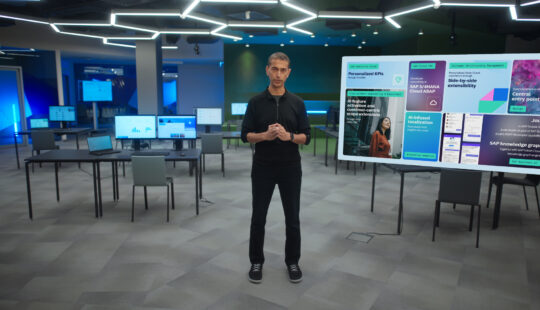Fifty years ago, the founders of SAP sat side-by-side with their clients’ business experts to co-develop groundbreaking solutions supporting the people and processes that power organizations. Now, the new low-code solution SAP Build honors that tradition by giving business experts the ability to directly drive the next wave of digital transformation.
SAP Build, a key component of SAP Business Technology Platform (SAP BTP), allows users with limited technical expertise to create enterprise apps, automate processes, and design business sites with an easy drag-and-drop interface.

In his keynote at SAP TechEd Las Vegas, SAP Chief Technology Officer and Member of the Executive Board Juergen Mueller announced SAP Build and an array of other innovations, including a partnership with Coursera to train and upskill the next generation of developers.
“SAP Build brings together the world’s most powerful business applications with a platform that’s been designed to rapidly unleash business users’ expertise,” Mueller said. “SAP Build and the full suite of innovations we’re launching today – from our new partnership with Coursera to enhancements across our enterprise portfolio – help customers future-proof their business and extract maximum value from their technology investments.”
Mueller’s message was echoed at parallel SAP Business Innovation Day events for industry analysts and press, hosted in San Francisco by Scott Russell, member of the Executive Board of SAP SE, Customer Success, and in Berlin by Thomas Saueressig, member of the Executive Board of SAP SE, SAP Product Engineering.
SAP Build is the evolution of SAP’s low-code portfolio that started with Build.me a few years ago and progressed with SAP AppGyver, unveiled in 2021. The new offering brings previously disconnected products into a unified and upgraded development environment. It comprises three solutions: SAP Build Process Automation; SAP Build Apps, the next version of SAP AppGyver with powerful new capabilities; and SAP Build Work Zone.
With SAP Build, business users now have the full power of SAP BTP and business application data from SAP at their fingertips. Users can easily integrate systems; intelligently monitor, analyze, and automate processes; and build applications without moving data into an external system.
In Berlin, Saueressig emphasized that SAP has been establishing business processes for 50 years and that hundreds of millions of people work with its software. “Of course, we need to make sure that the technology comes to an end user, but the goal is for users to innovate. We want to give tech-savvy business users the chance to extend our software, because even small extensions can have a big lever to scale innovation.”
Extensibility with low-code/no-code solutions is therefore particularly important. “This is what we want to achieve with SAP Build and bringing our low code portfolio together,” he said.
SAP Signavio solutions are also natively integrated, enabling SAP Build users to get in-depth visibility into all their processes, so they know where to focus to achieve the greatest impact as they innovate and automate. More than 275,000 process reference points from 4,000 customers, as well as 1,300 use case-specific workflows and automations, let users instantly tap into the full spectrum of business expertise built into SAP technology.
Speaking at the San Francisco event, Russell told his audience — which included customers like the NHL and Clorox — that being a cloud company is not just about having great technology, but also being accountable for how customers get there. “The move to the cloud was exciting not just for the tech benefits, but to become a partner on providing insights,” he said. “We are accountable for the outcome as much as the product.

SAP Build works with non-SAP systems and includes connectors to more than 200 other systems. Because SAP Build was created by SAP, access to business application data from SAP S/4HANA and other systems is easy and secure. Professional developers can encapsulate their code developed in SAP Business Application Studio, which can then be used by business users to develop in SAP Build. IT can also enforce consistent governance and lifecycle management capabilities across all apps being developed, providing confidence that all apps deployed by the business meet the necessary security and governance requirements.
“Compared to all the other [third-party] tools out there on the market, with SAP Build the company’s IT department and SAP set the guardrails with best practices,” Mueller said. “The business users cannot break these guardrails.”
While SAP Build is primarily designed to enable business users, SAP executives emphasized that it isn’t just for the business experts. It allows business teams to easily collaborate with development and IT teams, potentially shortening development time for more complex tasks. And the new SAP Builders program helps all types of users ramp up quickly and connect with their peers via hands-on sessions and forums for sharing best practices.
Is providing these robust capabilities to business experts a revolution to overthrow the IT department? Not at all, Mueller said, noting that according to IDC there is currently a worldwide shortage of nearly 1 million developers, which is projected to multiply to 4 million three years from now. “All the universities in the world, all the education programs in the world, cannot create enough developers,” he said.
Between the professional developer shortage and the ever-increasing demands of business users for new digital tools to support their businesses, something clearly needs to change. Enabling business users to create their own apps and other processes to meet specific needs will free up professional developers to focus on providing strategic insights and solving complex, higher-level problems where their expertise is so in demand. This combination of “low-code” and “pro-code” developers will allow organizations to quickly react and adapt to changing business needs.

The cadre of “citizen developers” is projected to grow exponentially over the coming years, taking the more mundane, yet often time-consuming, tasks off the to-do lists of overburdened IT staff. “Worldwide, IDC expects more than 100 million business professionals will become involved in the production of digital solutions over the next 10 years,” said Arnal Dayaratna, research vice president, Software Development, IDC. “SAP Build’s low-code development solutions empower business users to harness their domain expertise to rapidly build and iterate on digital solutions at scale.”
While SAP is all-in on enabling business experts with SAP Build, it also recognizes the increasing demand for the skills and insights only professional developers can deliver. Along with SAP Build, at SAP TechEd the company also announced several learning initiatives to both create a new pool of qualified IT professionals and upskill current ones.
SAP committed to upskilling 2 million developers worldwide by 2025 by tripling free learning offerings on the SAP Learning site, empowering underserved populations in technology, and partnering with learning platform provider Coursera on a professional certificate program to help people launch careers within the SAP ecosystem.
“This certificate is designed for learners of all backgrounds, with no college degree or industry experience required,” said Jeff Maggioncalda, CEO of Coursera. SAP will also launch a global skills initiative for underserved populations in technology, providing access to free learning, up to 10,000 free certifications, and career preparation for in-demand jobs within the SAP ecosystem.
“SAP Build is the natural evolution at SAP,” Mueller said. “For 50 years at SAP we focused a lot on the professional developer. We have all the tools and ABAP as a language optimized for building enterprise applications at scale very fast. Now, we bring all of this to the low-code community to give the millions of people who use SAP every day the opportunity to develop themselves and step up — in collaboration with IT. That’s what we do with SAP Build.”

*With additional reporting from Luis Trunk de Flores in Berlin and Mallory Kuno in San Francisco.
Top image © Josh Line Photography



